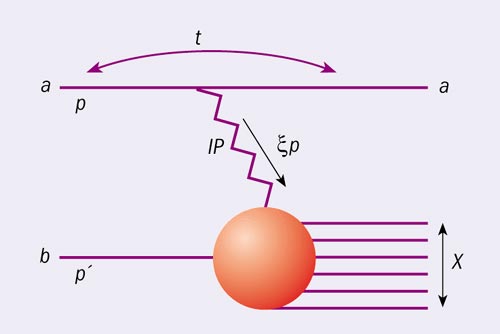by Sandy Donnachie, Günther Dosch, Peter Landshoff and Otto Nachtmann, Cambridge University Press. ISBN 052178039X, £70.

Just as in the diffraction of light, beams of elementary particles diffract off each other in scattering experiments at high energies. The resulting diffraction pattern contains crucial information on the nature of the strong force and, in particular, on the pomeron.
For more than 40 years now, particle physicists have been trying to understand the physics of particle scattering at high beam energies. Central to the theory is the notion of complex angular momentum pioneered by Tulio Regge, where single particle exchange is generalized to the exchange of a collaboration of many particles that collectively look like a single particle carrying complex angular momentum. The pomeron, named after Isaak Pomeranchuk, is the collective exchange that is dominant at high-enough beam energies.
This book carefully collects the key theoretical ideas and confronts them with the available data in a systematic way. Given that there is, as yet, no consensus on the exact nature of the pomeron and that the literature is often quite confused, such a well written and accessible book as this is most welcome. The authors present an approach based firmly on the theory of Regge and make very good use of both perturbative and non-perturbative QCD to help develop and support their ideas. The authors have considerable expertize and experience, which they particularly bring to bear when presenting their ideas on the use of non-perturbative techniques to study the pomeron. They are also the principal advocates of the idea that there may be two pomerons, with one pomeron dominant in soft interactions and the other dominant in hard interactions. Within this framework they succeed in presenting a rather coherent picture of the physics, notwithstanding that there are a few areas where the theory remains to be developed.
The book is quite pedagogical and is written at a level suitable for those who already have a good grasp of the basic elements of quantum field theory and elementary particle physics. There is a self-contained introduction to S-matrix theory and Regge poles, which provides the necessary foundation for the remainder of the book. Although there is a brief introduction to QCD, a prior exposure to QCD as a quantum gauge field theory would be helpful, particularly if one is to appreciate fully the sections that present the authors’ ideas in non-perturbative QCD.
Over the past 10 years, data from the HERA and Tevatron colliders have allowed us to make substantial advances in our understanding of high-energy processes. Continued understanding can be expected in the light of data that will come from future colliders and this book will, I suspect, continue to provide an excellent introduction to the subject.







